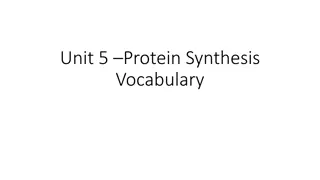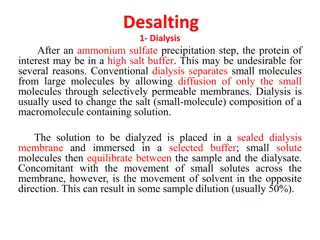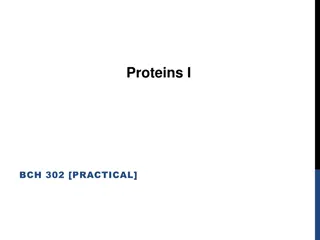
Protein Structures: Levels and Determination
Explore the intricate world of protein structures, from primary to tertiary levels, and learn how these molecules fold to carry out their biological functions. Discover the significance of structural domains, protein databases, and the methods used to determine protein structures.
Uploaded on | 0 Views
Download Presentation

Please find below an Image/Link to download the presentation.
The content on the website is provided AS IS for your information and personal use only. It may not be sold, licensed, or shared on other websites without obtaining consent from the author. If you encounter any issues during the download, it is possible that the publisher has removed the file from their server.
You are allowed to download the files provided on this website for personal or commercial use, subject to the condition that they are used lawfully. All files are the property of their respective owners.
The content on the website is provided AS IS for your information and personal use only. It may not be sold, licensed, or shared on other websites without obtaining consent from the author.
E N D
Presentation Transcript
StudyMafia.Org Protein Structures Submitted To: Studymafia.org Studymafia.org Submitted By:
Table Contents Definition Introduction Levels of protein structure Structural domain Protein structure determination Protein structure databases Conclusion 2
Definition Protein structure is the three-dimensional arrangement of atoms in an amino acid- chain molecule. Proteins are polymers specifically polypeptides formed from sequences of amino acids, the monomers of the polymer. 3
Introduction Proteins form by amino acids undergoing condensation reactions, in which the amino acids lose one water molecule per reaction in order to attach to one another with a peptide bond. By convention, a chain under 30 amino acids is often identified as a peptide, rather than a protein. To be able to perform their biological function, proteins fold into one or more specific spatial conformations driven by a number of non-covalent interactions such as hydrogen bonding, ionic interactions, Van der Waals forces, and hydrophobic packing. 4
Levels of protein structure Primary structure: The primary structure of a protein refers to the sequence of amino acids in the polypeptide chain. The primary structure is held together by peptide bonds that are made during the process of protein biosynthesis. The two ends of the polypeptide chain are referred to as the carboxyl terminus (C-terminus) and the amino terminus (N-terminus) based on the nature of the free group on each extremity. 5
Levels of protein structure Secondary structure : It refers to highly regular local sub-structures on the actual polypeptide backbone chain. Two main types of secondary structure, the -helix and the -strand or - sheets, were suggested in 1951 by Linus Pauling et al. These secondary structures are defined by patterns of hydrogen bonds between the main-chain peptide groups. 6
Levels of protein structure Tertiary structure: It refers to the three-dimensional structure created by a single protein molecule (a single polypeptide chain). It may include one or several domains. The -helixes and - pleated-sheets are folded into a compact globular structure. The folding is driven by the non-specific hydrophobic interactions, the burial of hydrophobic residues from water, but the structure is stable only when the parts of a protein domain are locked into place by specific tertiary interactions, such as salt bridges, hydrogen bonds, and the tight packing of side chains and disulfide bonds. 7
Levels of protein structure Quaternary structure It is the three-dimensional structure consisting of the aggregation of two or more individual polypeptide chains (subunits) that operate as a single functional unit (multimer). The resulting multimer is stabilized by the same non-covalent interactions and disulfide bonds as in tertiary structure. There are many possible quaternary structure organizations. Complexes of two or more polypeptides (i.e. multiple subunits) are called multimers. 8
Structural domain Astructural domain is an element of the protein's overall structure that is self-stabilizing and often folds independently of the rest of the protein chain. Many domains are not unique to the protein products of one gene or one gene family but instead appear in a variety of proteins. Domains often are named and singled out because they figure prominently in the biological function of the protein they belong to; for example, the "calcium-binding domain of calmodulin" 10
Protein structure determination Around 90% of the protein structures available in the Protein Data Bank have been determined by X-ray crystallography. This method allows one to measure the three- dimensional (3-D) density distribution of electrons in the protein, in the crystallized state, and thereby infer the 3- D coordinates of all the atoms to be determined to a certain resolution. Roughly 9% of the known protein structures have been obtained by nuclear magnetic resonance techniques. (NMR) 11
Protein structure databases A protein structure database is modeled determined protein structures. The aim of most protein structure databases is to organize and annotate the protein structures, providing the biological community access to the experimental data in a useful way. Data included in protein structure databases often includes 3D coordinates as well as experimental information, such as unit cell dimensions and angles for x-ray crystallography determined structures. is a database that various experimentally around the 12
Conclusion Proteins are built as chains of amino acids, which then fold into unique three-dimensional shapes. Bonding within protein molecules helps stabilize their structure, and the final folded forms of proteins are well-adapted for their functions. 13
References Google.com Wikipedia.org Studymafia.org Slidespanda.com
Thanks To StudyMafia.org






















